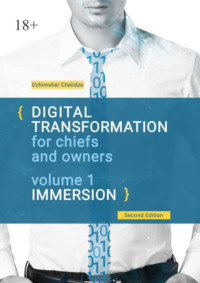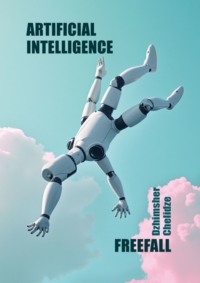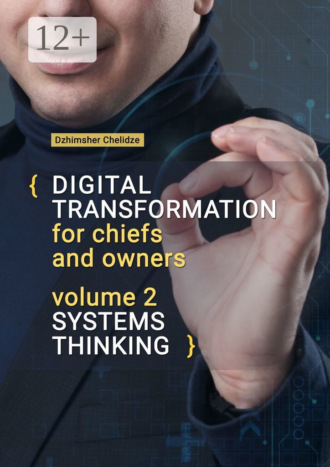
Полная версия
Digital transformation for chiefs and owners. Volume 2. Systems thinking

Digital transformation for chiefs and owners. Volume 2. Systems thinking
Dzhimsher Chelidze
© Dzhimsher Chelidze, 2024
ISBN 978-5-0064-2488-3 (т. 2)
ISBN 978-5-0064-2489-0
Created with Ridero smart publishing system
Foreword
If you are reading this book, you probably already understand what digital transformation is, why it is needed, and you have the realization that change is indispensable.
As I said in the first book, digital transformation is a management tool and a global redesign of the business model and the entire management system.
But what do you think I face personally in life? It is banal with the fact that there is no system, but there is either complete chaos and dependence on personalities (at best), or bureaucracy with the suppression of any personalities.
The book will focus on the implementation of a systems approach to management, without which any transformation will be a simulation.
I do not insist on the truth in the last instance, but every time such an approach was applied at least partially, the result amazed even me!
Do you think it’s possible from a community where no one wants anything to build a team with exemplary discipline to triple their productivity in three months? I will answer «yes» because I have achieved this result.
But to do that, first person involvement is needed. And without accumulated dissatisfaction with the situation and political will, all other manipulations and tools are meaningless.
We will go through the areas of the system approach, find out what key tools are needed for its implementation, what global practices already exist, and explore practical cases.
Therefore, what is the systemic approach I am promoting?
It is built on a combination of:
– Lean Manufacturing
Its mission is to continuously improve, eliminate losses, including through the use of digital technologies. Allows you to determine the objectives of the implementation of the figure, to build tactics.
– Project Management
Allows to minimize risks and budget.
– Using the product approach
Digital transformation must be accompanied by the creation of new products. Additionally, without the basic tools of food management, it’s almost a guaranteed failure. Additionally, then you won’t just be disappointed, you might end up on the verge of bankruptcy.
– System constraint theories
It allows for prioritization so that efficiency gains can be achieved with less investment. For example, a project for 3 million rubles, aimed at increasing productivity by 3 times, when applying the theory of system limitations, allows to reduce the budget to 1 million rubles, while receiving a 2.5-fold increase in productivity.
– Introduction of Changes
Digital transformation is about people and processes. The application of the main tools for implementing changes minimizes risks, resistance and the likelihood of a setback.
– Managing communication between units
Communication between units is a secret ingredient of both success and failure. Digital transformation is absolutely about the same – the ability to sit down, negotiate, hear each other. In my practice, all crises or problem projects / companies have one problem on the basis – cannot agree or do not hear each other, especially the top managers of their subordinates.
In general, working with SEO’s is very difficult. As a rule, these are people so-called «E-type» by Adises: entrepreneurs, bright and strong personalities, authoritarian, do not tolerate opinions different from their own.
These qualities help build companies, overcome the first problems – thanks to stubbornness, perseverance, authoritarianism, but then it begins to hinder business growth.
From this there is such a principle in management: centralization of power is needed at the start and at the collapse of the system, but for development decentralization is needed.
Which means the decision maker needs to change. However, when this man reaches the heights, he becomes stale, loses his former flexibility: he has gone the way, proved his worth, and now it is very difficult to recognize the need to change for further growth or the correctness of others’ opinions.
Now, can you imagine how a strong person like that would learn to detach from manual control?
– Using Digital Technologies and Data for Decision-Making
The first book was essentially devoted to this section. Digital transformation involves the active use of digital tools and analytics to minimize risks, create new products.
– Regular management practices
Digital technology will not fix chaotic controls, blurred targets, toxic communication, lack of control points. These are only tools that need the master’s hands.
– Working with strategy, organizational structure and business processes
Organizational structure and business processes are the foundation of an organization that supports the achievement of strategic goals. But they (structure, processes, strategy) are not eternal and must change over time.
Digitalization and digital transformation must become your strategic goal in order to «top» initiate all other changes.
Org. The structure aims to achieve the goals of the company by providing the necessary people with resources and dividing areas of responsibility.
When changing goals, strategies, available technologies (resources), you need to change the structure, allocation of resources and authority.
Therefore, you can shape the book’s message: digital transformation is one of the tools to achieve the goal; you can’t just implement one tool and hope that it will dramatically improve efficiency – you need integrated work.
Is it possible to master the whole approach one person? With due perseverance and consistency for 10—15 years – yes. Of course, no one has that much time, so the only way is to form a team with the right competencies.
Therefore, this book will be useful for both top managers of large organizations that can build work with middle managers, and managers of small companies.
P.S. This is the second edition of the book. In addition to minor adjustments to the original material, it is supplemented by two new chapters – what to teach staff and to what level, and a roadmap for digitalization and digital transformation. Practical examples of sharing systems approach tools have also been added.
Chapter 1. Organizational Structure and Business Processes
We will start with the organizational structure and work with business processes. If you translate into everyday language, org. The structure is the skeleton of the company, and the described, streamlined and efficient business processes are the nervous system.
The organizational structure is the basis for the management system. It achieves the company’s goals by providing resources to needed people and delineating areas of responsibility.
Additionally, when you have new technologies, changing goals, the company «matures» and moves to a new level, then business processes with organizational structure should change.
A clear and visualized organizational structure is a MUST. In my practice, there has never been a single case of a company operating smoothly without the organizational structure described, accessible and understandable to all.
Most often I observe the following:
1. There is no organizational structure. This is acceptable if you are 2—3 people, you are a strong manager and you have a strong team, you know how to negotiate among themselves. Otherwise, it is a realm of chaos. Even if you have the processes described.
2. The organizational structure is on paper, but in life quite differently. As they say, «waiting is reality».
3. There is an organizational structure, but it has no information about functions, powers, responsibilities. It’s not synchronized with the company’s goals, it’s not confined to team-building.
You can work without a description of business processes, but if there is a clear structure, with a description of functionality, key indicators and target product, it allows to radically improve efficiency and productivity, to establish a team relationship. Here the business processes described will allow to achieve even more efficiency, and subsequently to engage in automation and digitalization.
However, the business processes described will not work without a clear and understandable organizational structure, because you will not have a skeleton.
Types of organizational structures
It is now customary to identify several types of organizational structures:
– linear;
– functional;
– linear-functional or linear-stacked;
– divisional;
– market;
– matrix;
– food.
We’ll tear down each of them.
Linear
The simplest model: straight and hierarchical. Key decisions are made from the top, and they go down without any separate functions: sales, marketing, production. Suitable for small companies with simple manufacturing technology and minimal need for additional features.
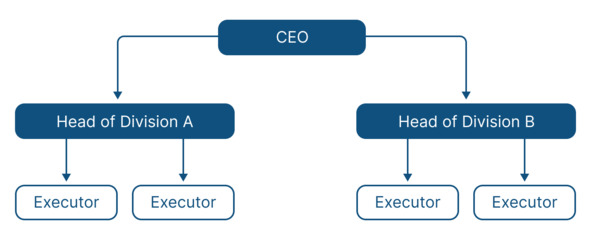
LINEAR
Pros:
– simplicity and speed of management decision-making;
– quick reaction to instructions and orders;
– a clear allocation of responsibilities and responsibilities;
– discipline.
Cons:
– overload of managers;
– concentration of a large amount of non-core work on managers;
– weak relationships between the performers;
– with the growth of the organization, the number of management levels increases rapidly, which reduces the flexibility of the company and the speed of response to changes.
Functional
The division of responsibilities is based on the functions performed: production, sale, marketing, accounting and tax accounting, financial management. At the end of the day, everyone takes his own direction. Optimal for small companies that work with one product, but require already more complex production organization.
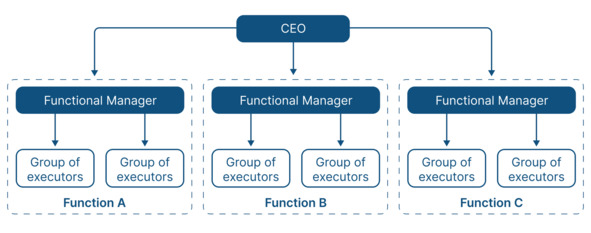
FUNCTIONAL
Pros:
– narrow specialization of directions – increase of productivity and quality;
– a clear allocation of responsibilities;
– exempting line managers from functions outside their competence;
– no duplication of functions (if business processes are built).
Disadvantage – the larger the company and the larger structure, the more difficult it is to organize the division and communication between the departments, while retaining the team interaction. Bureaucracy is beginning to flourish.
Linear-functional
The combination of distribution of linear and functional problems. In line management, there are production units where the manager is responsible for everything and support functions are performed by functional managers.
An example is a production hall with a technical director who is responsible for the work and discipline of the staff, the state of technology, productivity – in general, for everything. At the same time, there is a management apparatus, headquarters, where all support functions are carried out: procurement, search for contractors, travel arrangements and so on.
It is the most common among medium and large organizations, where people from a few hundred to a couple of thousand. Optimum in a stable environment: standard production processes, stable demand and external environment, without the need to implement a large number of projects and create new products.
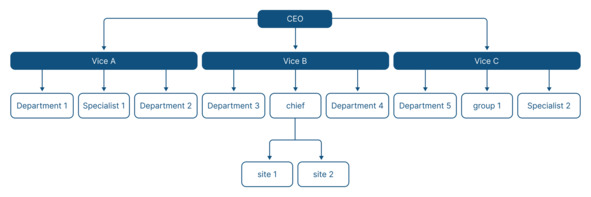
LINEAR-FUNCTIONAL
Pros:
– narrow specialization of directions – increase of productivity and quality;
– the ease and speed of managerial decision making;
– quick reaction to instructions and orders;
– minimizing duplication of work.
Disadvantages:
– high, sometimes unjustified, administrative staff costs;
– the growth of bureaucracy when functional managers are more interested in their security than in overall success.
Divisional / Market / Grocery
Similar to the linear structure, but the divisions are structured according to the principles of product or market separation. Optimal for companies with a large number of markets and heterogeneous products. For such enterprises it is necessary to create individual basic business processes for each product / region: supply, production, marketing, sales.
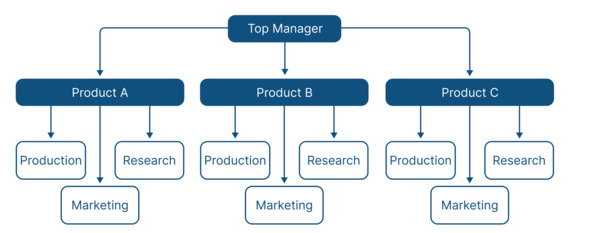
DIVISIONAL / MARKET / GROCERY
Pros:
– flexibility – individual strategies and business processes can be developed for each product / region;
– easy coordination and coordination of management decisions;
– high speed of response to emerging problems;
– high performance and management quality thanks to specialization.
Cons:
– as in previous models, there may not be a common goal, each for himself;
– unhealthy competition between structures and directions, growing political differences;
– different productivity;
– low budget efficiency.
Matrix
It is a complex model designed primarily for project implementation. A staff member may have multiple supervisors, and project and resource management is entrusted to the project manager / office.
Sometimes attempts are made to create hybrids of linear-functional and matrix models, where the implementation of projects is entrusted to functional managers. For example, an industrial safety system is being introduced and the head of the industrial safety department becomes.
Pros:
– is responsible for the implementation of a manager with high professional competence;
– the project manager can influence the situation at his own discretion, without unnecessary control (but this is rare).
Disadvantages:
– complexity in the implementation of projects and allocation of responsibilities, conflicts of interest, requires a high level of competence at the manager;
– low performance;
– duplicate functions.
I will give an example of the implementation of this approach.
Integrated corporation with central apparatus in Moscow and a large number of regional units with linear-functional structure.
The central office initiates the implementation of a complex IT system that covers a large number of business processes and requires the inclusion of both technical and financial and HR. In each regional division a responsible manager is appointed and fun starts… The manager is responsible for the whole project, but the resources and authority to manage other people’s (financial, HR) blocks are not, and the desire of others to change at will is even more so. The curator in the central apparatus is not all-powerful and is also located within the functional subdivision. In general, to implement such a project – a hell of a quest.
Matrix structures can also be divided into weak, strong and balanced.
The weak
Weak matrix structures are used when there are many projects, but they are small and not routine, not critical for the company.
In a weak matrix, the members of the project team are managed by functional managers (Chief of Industrial Safety, Repair Planning, Procurement) whose authority is limited: each is responsible for his or her direction.
There has to be a project manager who reports to management or, in this case, central office, gets his tasks. Tasks are then decomposed into smaller tasks and assigned to functional staff. But in fact, it has no powers and no resources. It is fertile ground for conflict.
It is also possible to have «forwarders». These are people in functional areas who disseminate information but have no authority – informal leaders of opinion.
As we can see, this approach is not applicable to our large-scale project. Unless we have very charismatic and strong project managers on the ground.
The strong
Differ in that the implementation of such a project may not be one, but several managers, or the manager and team, and they have much more authority. They can now not simply hand over tasks, but also give orders, require tasks and project reporting from functional managers. In addition, the project team may not be a permanent part of the functions, that is, it is possible that they will deal only with the project, plus they can search for contractors or order raw materials.
For our conditional IT system implementation project, this approach may be redundant. Although, perhaps, it will increase the chances of success, but such implementation comes out very expensive.
Balanced
In this case, the project manager is appointed from among the staff and, better, from the functional managers. Here he can set tasks and monitor their performance. However, it is likely not to be exempt from its operational tasks and to be unable to manage its own resources.
It is worth noting that this is the most difficult option to implement, as it involves the largest number of assigned roles, moreover, there may also be issues with subordination and, consequently, matrix conflicts.
Summary
We have dismantled the main types of org. structures. It would seem, choose the right, suitable for your company, and everything will be fine. Alas, it is not so. It is important to distribute functions and powers correctly, to identify a key product of the activity, to choose the people for whom this work is suitable psychologically, and also to build communication between them. That is why I always speak of a systems approach: it is impossible to implement any one tool – integration is needed.
Besides, as we can see, already at org level. The structure is related to the number and size of the projects implemented, that is, there is a close interweaving of work with the organization. structures and project management, they become inseparable.
To consolidate all practice, I propose to look at one real example with two structures of the same type, but with a completely different substance. Since the organizational structure in the book is almost impossible to display, everything will be available via QR and the link below.

Organizational Structures
Additionally, it should be remembered that with the development and organization. structure, and distribution of functions should change.
In addition, there is a trend in the world to avoid large bureaucratic structures. Why? In addition to economic factors and long transmission chains, this is a breeding ground of irresponsibility. As a result, there are a lot of people in charge, but all are formally covered up, and Ivan’s locksmith is to blame.
Here is a practical example: the repair of industrial equipment has been exceeded due to a chain of events: could not form a brigade because one of its members failed the exam because the head of the service could not form a commission for the exam, because two people on the commission were on vacation… Additionally, nobody seems to blame, but in the end, the object is worth… Until the Chief Engineer, in a terrible curse, corrects the situation in the simplest but not the most obvious way for all listed.
This case isn’t really just about an organizational structure where, under the guise of collective responsibility, the mess is going on. It is also about the corporate culture, which is based on the direct execution of rules (the culture of rules), and formed it the same chief engineer and his predecessors.
Could even in this structure avoid these problems? Of course! With proper work of managers, building of control points, informal communication, leadership qualities of this situation would not be. Additionally, here the main thesis that will go through the book – it is impossible to build an effective business system with one tool.
Main approaches to modelling and description of business processes
Introduction
In addition to organizational structures, there is another key area – business processes.
A complete list of almost all approaches to description with illustrations, display examples and videos available IT-solutions is provided by QR-code and link below.

Business processes: notification and modeling, what to choose?
Here I will consider the most common ones, answer who they are, show what I observe in life, use it myself, and summarize – what is more important: structure or business processes?
I understand that all this may seem boring, but in practice I have learned one simple rule – there is nothing worse than arguments «it is so clear», «it is too simple». Always, when I have met such arguments, this has not boded well. These theses are harbingers of chaos and disorderly problems. So, I chose this structure: first a little bit of general theory, then practice and working principles.
Basic approaches to the description of business processes
A business process is a certain algorithm of interrelated actions of people and IT systems, which is aimed at transformation of «raw materials» into «product» or result.
For example, the business procurement process involves the following stages: requisition, sourcing, solicitation, delivery of materials, delivery to the requisitioner. But each stage is also broken down into separate business processes. Therefore, you need to understand that the description of business processes is almost infinite task, and you will need to choose the level of detail, at which you say «all, enough». The lower the level of command competence, the more detailed should be made the description. Or you need to train the team, but then you have to grow as a leader. Smart personnel will not tolerate treatment as fools.
Conventionally there are several approaches to the description of business processes:
– Value Chain Diagrams (value added chain diagram, VAD);
– SIPOC;
– Event-driven process chain (EPC);
– BPMN 2.0 (Business Process Model and Notation 2.0);
– Flow Charting (Process and Procedure notations);
– IDEF (Integrated Definition Language);
– UML (Unified Modeling Languages);
– VSM (Value Stream Mapping);
– ARIS;
– DFD.
Value Chain Diagrams (VAD)
An approach that allows you to describe at the highest level the key activities of the company and departments, show the relationships between them. Here the focus is on graphical display of business processes that create value for the client.
That is, it is a kind of «master model», which gives the whole team an understanding of how its work affects the company as a whole.
Rules of construction of VAD-model of the value-added process:
– To begin with, it is necessary to identify the key tasks of the company or division that characterize its activities.
– Their logical relationship is then constructed.
– The owner and the unit responsible for the process shall be identified and specified.
– The main documents regulating the business process are indicated.
– Additional information and resources required to complete the business process are indicated.
– Links to lower-level diagrams (VAD or EPC) are attached to each upper-level business process.
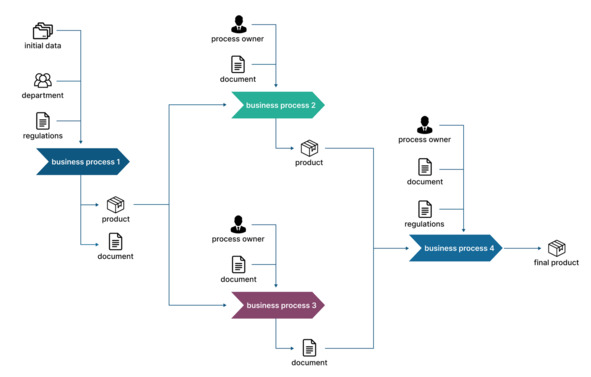
An example of a VAD scheme
SIPOC
Approach to the description of business processes, which is a tool in lean production. The title reflects the whole essence of the approach, which focuses on five components:





